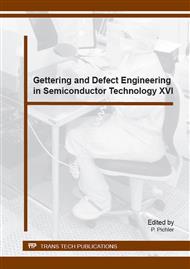[1]
I. E. Bondarenko, V. G. Eremenko, B. Ya. Farber, V. I. Nikitenko, E. B. Yakimov, On the real structure of monocrystalline silicon near dislocation slip planes, Phys. Stat. Sol. A 68 (1981) 53.
DOI: 10.1002/pssa.2210680107
Google Scholar
[2]
V. Eremenko, E. Yakimov, N. Abrosimov, Structure and recombination properties of extended defects in the dislocation slip plane in silicon, Phys. Stat. Sol. C 4 (2007) 3100-3104.
DOI: 10.1002/pssc.200675462
Google Scholar
[3]
O. V. Feklisova, E. B. Yakimov, Electrical properties of dislocation trails in n-Si, Phys. Stat. Sol. C 4 (2007) 3105-3109.
DOI: 10.1002/pssc.200675464
Google Scholar
[4]
O. V. Feklisova, E. B. Yakimov, N. Yarykin, B. Pichaud, Temperature dependence of electron beam induced current contrast of deformation-induced defects in silicon, J. Phys.: Condens. Matter 16 (2004) 201-205.
DOI: 10.1088/0953-8984/16/2/023
Google Scholar
[5]
O. V. Feklisova, B. Pichaud, E. B. Yakimov, Annealing effect on the electrical activity of extended defects in plastically deformed p-Si with low dislocation density, Phys. Stat. Sol. A 202 (2005) 896-900.
DOI: 10.1002/pssa.200460511
Google Scholar
[6]
O. V. Feklisova, E. B. Yakimov, N. Yarykin, Contribution of the disturbed dislocation slip planes to the electrical properties of plastically deformed silicon, Physica B 340–342 (2003) 1005-1008.
DOI: 10.1016/j.physb.2003.09.196
Google Scholar
[7]
М. А. Khorosheva, V. V. Kveder, M. Seibt, On the nature of defects produced by motion of dislocations in silicon, accepted for publication in Phys. Stat. Sol. A (2015).
DOI: 10.1002/pssa.201532153
Google Scholar
[8]
A. Rodriguez, H. Bracht, I. Yonenaga, Impact of high B concentrations and high dislocation densities on Au diffusion in Si, J. Appl. Phys. 95 (2004) 7841-7849.
DOI: 10.1063/1.1751235
Google Scholar
[9]
N.A. Stolwijk, J. Holzel, W. Frank, E.R. Weber, H. Mehrer, Diffusion of Gold in Dislocation-Free or Highly Dislocated Silicon Measured by the Spreading-Resistance Technique, Appl. Phys. A 39 (1986) 37-48.
DOI: 10.1007/bf01177162
Google Scholar
[10]
H. Kitagawa and M. Yoshida, On the Distinction between the Dissociative and Kick-Out Mechanisms for Site Exchange in Silicon, Jpn. J. Appl. Phys. 31 (1992) 2859.
DOI: 10.1143/jjap.31.2859
Google Scholar
[11]
E. Weber, Transition Metals in Silicon, Appl. Phys. A 30 (1983) 1-22.
Google Scholar
[12]
M. A. Khorosheva, V. I. Orlov, N. V. Abrosimov, V. V. Kveder, Determination of the nonequilibrium concentration of vacancies in silicon crystals by measuring the concentration if nickel atoms at lattice sites, JETP 110 (2010) 769-774.
DOI: 10.1134/s1063776110050067
Google Scholar
[13]
V. Kveder, Yu. Osipyan, W. Schröter, G. Zoth, On the energy spectrum of dislocations in silicon, Phys. Stat. Sol. A 72 (1982) 701-713.
DOI: 10.1002/pssa.2210720233
Google Scholar
[14]
V. Kveder, M. Badylevich, E. Steinman, A. Izotov, M. Seibt, W. Schröter, Room-temperature silicon light-emitting diodes based on dislocation luminescence, Appl. Phys. Lett. 84 (2004) 2106-2108.
DOI: 10.1063/1.1689402
Google Scholar
[15]
M. Jacob, P. Pichler, H. Ryssel, R. Falster, Determination of vacancy concentrations in the bulk of silicon wafers by platinum diffusion experiments, J. Appl. Phys. 82 (1997) 182-191.
DOI: 10.1063/1.365796
Google Scholar
[16]
H. Zimmermann, Vacancy Distributions in Silicon and Methods for their Accurate Determination, Defect and Diffusion Forum 153-15 (1998) 111-136.
DOI: 10.4028/www.scientific.net/ddf.153-155.111
Google Scholar
[17]
E. Sveinbjörnsson, O. Engström, Reaction kinetics of hydrogen-gold complexes in silicon, Phys. Rev. B 52 (1995) 4884-4895.
DOI: 10.1103/physrevb.52.4884
Google Scholar
[18]
P. Omling, E. Weber, L. Montelius, H. Alexander, J. Michel, Electrical properties of dislocations and point defects in plastically deformed silicon, Phys. Rev. B 32 (1985) 6571-6581.
DOI: 10.1103/physrevb.32.6571
Google Scholar
[19]
D. Cavalcoli, A. Cavallini, E. Gombia, Defect states in plastically deformed n-type silicon, Phys. Rev. B 56 (1997) 10208-10214.
DOI: 10.1103/physrevb.56.10208
Google Scholar
[20]
V. Kveder, V. Orlov, M. Khorosheva, M. Seibt, Influence of the Dislocation Travel Distance on the DLTS Spectra of Dislocations in Cz-Si, Sol. Stat. Phenom. 131-133 (2008) 175-181.
DOI: 10.4028/www.scientific.net/ssp.131-133.175
Google Scholar
[21]
D. J. Backlund and S. K. Estreicher, Ti, Fe, and Ni in Si and their interactions with the vacancy and the A center: A theoretical study, Phys. Rev. B 81 (2010) 235213.
Google Scholar
[22]
E. Kamiyama, K. Sueoka and J. Vanhellemont, Formation Energy of Intrinsic Point Defects in Si and Ge and Implications for Ge Crystal Growth Electronic Materials and Processing, Journal of Solid State Science and Technology, 2 (2013) 104-109.
DOI: 10.1149/2.002304jss
Google Scholar
[23]
V. Kveder, M. Kittler, W. Schröter, Temperature dependence of the recombination activity at contaminated dislocations in Si: A model describing the different EBIC contrast behavior, Phys. Rev. B 63 (2001) 115208.
DOI: 10.4028/www.scientific.net/ssp.69-70.417
Google Scholar
[24]
V. Kveder, M. Badylevich, W. Schröter, M. Seibt, E. Steinman, A. Izotov, Silicon light-emitting diodes based on dislocation-related luminescence, Phys. Stat. Sol. A 202 (2005) 901–910.
DOI: 10.1002/pssa.200460512
Google Scholar
[25]
M. Seibt, A. Sattler, C. Rudolf, O. Voß, V. Kveder, W. Schröter, Gettering in silicon photovoltaics: current state and future perspectives, Phys. Stat. Sol. (a) 203, (2006) 696–713.
DOI: 10.1002/pssa.200664516
Google Scholar


